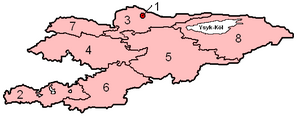Political system of Kyrgyzstan
The political system of Kyrgyzstan is characterized by the democratic revolutions of the so-called Tulip Revolution in 2005, in which the increasingly authoritarian ruling President Askar Akayev was forced to leave the country.
Kyrgyzstan is a republic and has been independent from the Soviet Union since 1991 . After the rights of the president were further strengthened after the tulip revolution, after the overthrow of Kurmanbek Bakiyev in April 2010, democratic forces prevailed, which promoted the transformation of Kyrgyzstan into a parliamentary republic .
Constitution
The previous constitution of the Kyrgyz Republic was adopted in 1993 and defines Kyrgyzstan as a representative democratic republic with a separation of powers and numerous basic rights of the citizens. It also contains articles on the independence of the courts. However, constitutional amendments and constitutional referenda in 1996, 1998, 2003 and 2007 expanded the strong position of the president even further.
After the overthrow of the increasingly authoritarian President Bakiyev, the interim government under the former Foreign Minister Rosa Otunbajewa drafted a new constitution based on the German model , which is intended to strengthen the legislature's rights towards a parliamentary republic. The constitutional amendments were adopted in a referendum on June 27, 2010 by more than 90% of the voters.
Government system
Since the democratic reforms in the Kyrgyz SSR in the course of independence in 1991, the country has been a presidential republic with a semi-presidential system of government , since there is both the office of president and the office of prime minister , but the president has far-reaching powers and therefore more political powers Power than the prime minister holds. The head of state is the president, the prime minister is the head of government of the country. The president is elected every 5 years by direct election by the people. He appoints the prime minister, who has to be confirmed by parliament. He also appoints the members of the government cabinet and the governors of the territories of the country. The President has been Sooronbai Dscheenbekow since November 2017 . The prime minister is Muchammedkaly Abylgaziev .
legislation
The parliament ( Dschogorku Kengesch ) , which consists of 90 members, is re-elected every 5 years, with members being elected exclusively via party lists using proportional representation. The right to vote applies to all Kyrgyz citizens from the age of 18, from the age of 25 the Kyrgyz have the right to be put up for election. A nationwide 5% threshold applies to the parties ; in the seven oblasts as well as in the cities of Bishkek and Osh , the party must reach 0.5%.
The parties are usually not particularly programmatic and therefore play a different role in forming political opinion than in Western democracies. There are around 80 political parties in the country, but only 12 of them were registered for the December 2007 parliamentary election. The most influential party is the Ak Dschol presidential party , the main opposition parties are the Ata-Meken , Respublika , as well as Ar-Namys and Ata-Shurt . The largest opposition party currently represented in parliament is the Kyrgyz Social Democratic Party . The Communist Party of Kyrgyzstan is also represented in parliament .
jurisdiction
Although the country's constitution provides for the independence of the judiciary , the judges and courts are under the strong influence of the president. The legal system often dates back to the time when Kyrgyzstan, when the Kyrgyz SSR was part of the Soviet Union. It is therefore very different from the legal systems of western countries. Corruption is widespread in the country. Transparency International ranks the country among the twenty countries in the world with the highest level of corruption. On the Corruption Perceptions Index 2010, the country ranks 164th out of 178 with a score of 2.0 on a scale from 0 to 10 (0 being very corrupt and 10 being not corrupt ).
administration
The Kyrgyz Republic is divided into seven regions ( German also oblasts ; kirgis. Область / oblast , pl. Областтар / oblasttar ) and the capital district (шаар / schaar, German city ) Bishkek , which does not belong to any oblast. The oblasts subdivide themselves into 40 so-called districts (район / rajon, pl. Райондор / rajondor ). The capital Bishkek is divided into four separate districts. The districts in turn are subdivided into a total of 473 rural so-called local administrations (айыл өкмөтү / ajyl Ökmötü , German village government ) and 22 other cities.
The individual oblasts and districts are: Batken (Баткен областы; 2) having capital Batken, Chu River (областы Чүй; 3) with the capital Tokmok , Jalalabat (Жалалабат областы; 4) with the capital Jalalabat , Naryn (Нарын областы; 5) with the capital Naryn , Osh (Ош областы; 6) with the capital Osh , Talas (Талас областы; 7) with the capital Talas , Yissikull (Ысыккөл областы; 8) with the capital Karakol and the capital district city of Bishkek (Бишасрыкел; ).
Individual evidence
- ↑ Tulip Revolution in Kyrgyzstan ( Memento from August 21, 2009 in the Internet Archive ) NZZ Online, March 26, 2005.
- ↑ Die Presse: Kyrgyz people vote for new constitution , June 28, 2010.
- ^ Right to vote in Kyrgyzstan
- ^ OSCE Center in Bishkek strengthens political parties in south of Kyrgyzstan .
- ↑ Final report of the OSCE on the early parliamentary elections of December 16, 2007 (PDF; 259 kB), April 24, 2008 (English).
- ↑ Profile of the country of Kyrgyzstan (PDF; 112 kB). Library of Congress Federal Research Division (January 2007). This article is in the public domain .
- ^ Transparency International. Retrieved February 2, 2011.
